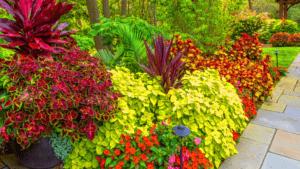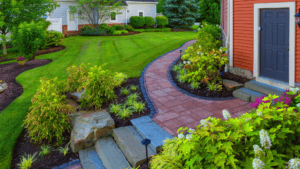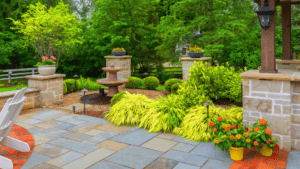Keeping your outdoor plants alive and healthy can be a daunting task, but with a little bit of know-how, it can be accomplished with ease. This blog post will outline some simple steps you can take to make sure your plants are flourishing all season long. So whether you’re a gardening novice or an expert green thumb, read on for tips and tricks that will help you keep your outdoor plants thriving!
Which Plant is Best for Outdoors?
There are a plethora of plants that are suitable outdoors. After all, that’s where most of them came from and thrive naturally! It would take all day to list them all so you’re encouraged to do more research into what best suits your likes. Here are a few of either low-maintenance outdoor plants or ones that are well worth the effort and care. Many of these are perennials-which grow back more than two years over and over.
You are watching: Outdoor Plants: How To Keep Them Healthy and Alive
Coneflower
Coneflowers are beautifully bright-colored flowers that bloom mid-summer. There are many different varieties in many colors. Deers will keep their pesky tastes far away from these as well. They do, however, attract butterflies and bees. Keep in mind that these little beauties require a lot of sunlight to thrive.
Chrysanthemums
These fall flowers love sun, so be sure they get plenty of it. They are cold-hardy though so don’t worry about when the weather drops. They come in almost any color you’d want! Most aren’t perennial, though, so you’ll have to replenish the following year. But these little beauties are sure to bring a star to your eye.
Canna Lillies
Canna Lilly blooms are colorfully-bright and flamboyant. They are tall plants even without their flowers blooming. These are the perfect outdoor plant to bring a little flair to your lawn and garden. Cannas are adaptable to partial shade, but require at least four hours of direct sunlight a day. They grow best in fertile and moist soil. They should be planted in loose soil with 2 to 4 inches of compost.
Herbs
Herbs are a fan favorite when it comes to outdoor plants. There are a plethora of plant options for your herb garden. Some of the top favorites are chives. Chives are relatively hardy and low maintenance. They can be planted in a pot or in the ground. Just make sure they get plenty of sunlight. Other herbs like basil and oregano are also easy additions as outdoor plants. Any herbs you have can be taken inside during the winter months to keep them growing all year long! Herbs mostly just need fertile, moist soil and plenty of sunlight.
Hydrangeas
These spectacular shrubs are sure to brighten anyone’s lawn and garden. They’re one of the easiest outdoor plants to grow and keep healthy as well. They can thrive in almost any soil type and only require partial sunlight. But be sure to keep those leaves out of the direct sun on those super hot days, as their leaves are prone to wilting. Hydrangeas come in light blues, vibrant pinks, white, lavender and rose-colored blossoms. Some plants even have multiple colors all on one!
Roses
A staple choice for outdoor plants are roses. When you plant your roses make sure they have a nice spot in the sun that allows good drainage. Your roses are sure to impress, especially if you use fertilizer. Make sure to keep the soil moist throughout the season. And as we all know, every rose has its thorns so be sure to prune them in early spring. They will keep coming back bigger and better each year too!
Strawberries
Who doesn’t love a good juicy strawberry in the summer? These perennials are relatively low maintenance. Be sure to plant them in taller or protected pots, though. Our furry friends like to feast on these red gems as well.
Is it Possible to Revive a Dying Plant?
While it may be possible to revive a dying plant, it is often difficult to do so. If a plant is wilting, its leaves are drooping, and its stems are weak, it is likely that it is suffering from dehydration. To revive a dehydrated plant, water it thoroughly and then provide it with plenty of shade.
If a plant is suffering from too much sun, its leaves will be yellow or brown. To revive a sun-scorched plant, move it to a shadier location and make sure to water it regularly.
If a plant is wilting and its leaves are turning black, it is likely that it is suffering from disease or pests. To revive a sick plant, remove any diseased or pest-infested parts and then treat the plant with an appropriate pesticide or fungicide.
Finally, if a plant is wilting and its leaves are browning, it is likely that it has been overwatered. To revive an overwatered outdoor plant, allow the soil to dry out completely before watering it again. With proper care and patience, it may be possible to revive a dying plant. However, sometimes the best course of action is simply to start anew.
7 Tips To Keep Your Outdoor Plants Healthy and Alive
Read more : How we hung our Deck String Lights, Privacy Screen and Artwork Outside
If you’re like most people, you probably take great pride in having beautiful plants around your house. Not only do they add a touch of elegance, but they also make your home feel more alive and welcoming. However, keeping outdoor plants healthy and alive can be tricky, especially if you don’t have a green thumb. Thankfully, there are plenty of tips and tricks that you can use to make the process a little bit easier. So if you’re looking for ways to keep your outdoor plants happy and healthy, read on for some helpful advice.
Inspect Your Outdoor Plants Regularly
As the saying goes, “April showers bring May flowers.” However, before you can enjoy the fruits of your gardening labor, you need to put in some regular effort to care for your outdoor plants. That means inspecting them regularly for signs of disease or pests. Otherwise, you risk your plants becoming unhealthy and perhaps even dying.
Fortunately, inspecting your outdoor plants is relatively easy to do. Start by taking a close look at the leaves and stems. Are there any brown or yellow patches? Any black spots? These could be signs of a problem. Next, check the soil around the plant. Is it loose and crumbly, or is it compacted and hard? The ideal texture is somewhere in between.
Finally, take a step back and look at the plant as a whole. Are all the leaves pointing in the same direction? Is it leaning to one side? These are both signs that the plant is not getting enough light.
By taking the time to inspect your outdoor plants on a regular basis, you can spot problems early and take steps to prevent them from getting worse. As a result, you’ll be able to enjoy a beautiful lawn and garden all season long.
Avoid Under/Overwatering Your Plants
One of the most important things to avoid is underwatering or overwatering your plants. Underwatering outdoor plants can cause them to wilt and die, while overwatering can lead to fungal growth and other problems. The key is to find a happy medium, and here are a few tips to help you do just that.
First, make sure you know how often your particular plant needs water. Some plants need to be watered daily, while others can survive on weekly watering. Once you know how often to water, stick to that schedule as closely as possible.
Second, pay attention to the weather. If it’s been particularly hot or dry, your plants will likely need more water than usual. Conversely, if it’s been cool or wet, they may need less.
Finally, get to know your plants’ individual watering needs. Some plants like their soil to be moist at all times, while others prefer it on the drier side. By taking the time to learn about your plants, you’ll be able to give them the perfect amount of water – not too much and not too little.
Add Mulch to Garden Soil
When it comes to outdoor plants, soil is key. Gardeners know that healthy soil is the foundation for a thriving lawn or garden. Not only does it provide nutrients and support for roots, but it also helps to regulate moisture levels and prevent weed growth. However, outdoor plants can also be threatened by erosion, which can damage roots and make it difficult for new seedlings to take hold.
One way to help prevent erosion is to add mulch to garden soil. Mulch is a layer of material (usually organic matter like bark or leaves) that helps to protect the soil from wind and water damage. It also helps to keep the soil moist by preventing evaporation. In addition, mulch can add important nutrients to the soil as it breaks down over time. As a result, adding mulch to garden soil is a simple and effective way to help protect outdoor plants from erosion and improve overall plant health.
Cull and Prune Your Plants
Another one of the most important things you can do for your outdoor plants is to cull and prune them on a regular basis. This helps to keep them healthy and prevents them from taking over your lawn and garden. When you prune a plant, you remove dead or dying leaves, stems, and branches.
This not only makes the plant look better, but it also helps to encourage new growth. In addition, pruning can help to control the size and shape of a plant. If you have a plant that is getting too big or sprawling out of control, pruning can help to keep it in check.
Read more : Best Exterior Polyurethane – Complete Overview
Similarly, if you want to encourage a plant to produce more flowers or fruits, pruning can help to stimulate new growth. Whether you’re an experienced gardener or just getting started, culling and pruning your outdoor plants is an essential part of keeping them healthy and under control.
Keep Animals or Pests Away
Outdoor plants are a great way to enjoy nature without having to deal with the mess and upkeep of a full-fledged garden. However, keeping outdoor plants can pose some challenges, such as keeping animals and pests away. The following tips can help you keep your outdoor plants safe from hungry critters.
One way to keep animals away from your outdoor plants is to choose plants that they don’t like. Many animals are deterred by strong scents, so herbs like mint or lavender can be good choices. You can also try planting prickly plants, like roses or cacti. If you have a lot of trouble with animals, you may want to consider investing in a fence. A simple chicken wire fence can be enough to keep out smaller critters, while a sturdier fence may be necessary to keep out larger animals.
Pests can also be a problem for outdoor plants. One way to combat pests is to choose plants that are known to be resistant to pests. You can also try using natural pest control methods, such as introducing ladybugs or other beneficial insects into your garden. If you do use chemical pesticides, be sure to follow the instructions carefully and only use them as a last resort.
Observe Proper Plant Spacing
Outdoor plants are a key part of any lawn and garden. By observing the proper spacing of your outdoor plants, you can ensure that your gardening is both efficient and effective. Outdoor plants require different amounts of space depending on their size and growth habits.
Large trees and shrubs need more space to spread their roots and branches, while smaller annuals and perennials can be planted closer together. By observing proper spacing, you can create a healthy environment for your outdoor plants to thrive. In addition, proper spacing can help to prevent the spread of disease and pests. Giving each plant the space it needs, can help to create a healthy and beautiful garden.
Choose the Right Soil for the Plant
One of the most important considerations for any gardener is choosing the right soil for their plants. Outdoor plants, in particular, need soil that is rich in nutrients and able to retain moisture. Otherwise, they will quickly become dehydrated or dried out.
There are a few different ways to choose the best soil for your outdoor plants. First, consider the location of the plant. If it is in a sunny spot, you will need to choose soil that drains well. If the plant is in a shady spot, on the other hand, you will need to choose soil that retains moisture.
Another factor to consider is the type of plant you are growing. Some plants, such as succulents, prefer sandy soils, while others, such as ferns, prefer damp soils. Finally, consider your own gardening style. If you are someone who likes to water your plants regularly, you will need to choose soil that drains well.
If you are someone who forgets to water your plants often, on the other hand, you will need to choose soil that retains moisture. By taking all of these factors into consideration, you can be sure to choose the right soil for your outdoor plants.
You’re All Ready to Grow
Outdoor plants can be a beautiful addition to any home, and with the right care, they can last for years. If you’re wondering how to keep your outdoor plants alive and healthy, don’t worry – we’ve got you covered.
In this blog post, we outlined some tips to help you out, as well as some of the best plants for the outdoors. We also talked about how to revive a dying plant. So if one of your plants is looking a little worse for wear, don’t give up on it just yet! With a little TLC, it may be able to recover and thrive once again.
Ready to get started? Call Exscape Designs today and let us help you grow!
Source: https://gardencourte.com
Categories: Outdoor




